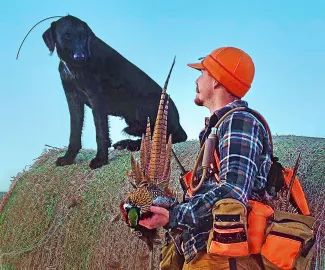
Success in the field for pheasant hunters in northern and northwestern Oklahoma might be more likely this year, according to the Wildlife Department's annual roadside surveys. (Photo by Bransen Shelton/Readers' Photo Showcase 2020)
Surveys Predict Slightly Improved Bird Numbers Over 2020
Oklahoma’s ring-necked pheasant hunting season will open Wednesday, Dec. 1, and hunters planning to pursue this exotic species might find slightly better bird numbers in the field this year, based on results from annual roadside surveys conducted by the Oklahoma Department of Wildlife Conservation.
“I anticipate numbers to be equal to or slightly improved over 2020, depending on the area, but still below the 10-year average,” said Tell Judkins, Upland Game Biologist for the Wildlife Department.
This year’s crow count survey suggested fewer cock pheasants in the field compared to last year. The brood count provided generally the same numbers that were seen in 2020. For details from both surveys, check out the 2021-22 Pheasant Season Outlook online at wildlifedepartment.com.
“February's severe winter storm combined with the spring hail events led to fewer adults going into the nesting season than normal. However, rainfall throughout the spring allowed for a great crop of forbs and insects, which allowed for better brood success in some areas over others,” Judkins said.
Hunters seeking places to hunt pheasant are reminded that the Department’s OLAP (Oklahoma Land Access Program) offers many walk-in hunting opportunities across the pheasant’s range in the state. For details, go to the OLAP webpage.
The Wildlife Department conducts two pheasant surveys: a count of the number of crowing male birds heard per mile along 20-mile routes during April and May, and a count of the number of broods seen per mile along 20-mile routes during late August. The surveys are conducted in Alfalfa, Beaver, Cimarron, Ellis, Garfield, Grant, Harper, Kay, Major, Noble, Texas, Woods and Woodward counties.
Results are reported as an index for all the counties combined, but also for a subset of counties that traditionally has the highest pheasant densities: Alfalfa, Beaver, Cimarron, Grant and Texas counties. The indexes provide insight into the pheasant population over entire regions, and not necessarily for localized areas.
During crowing count surveys in spring, biologists drive county roads and listen for crowing cocks in search of mates. The number of crows heard yields an idea of how many adult males will enter the breeding season.
Pheasant hunting season will run through Jan. 31, and the daily bag limit is two cock pheasants only. Hunters must wear daylight fluorescent orange clothing when required.
Areas open to pheasant hunting are Alfalfa, Beaver, Cimarron, Garfield, Grant, Harper, Kay, Major, Noble, Osage, Texas, Woods and Woodward counties, as well as the portions of Blaine, Dewey, Ellis, Kingfisher and Logan counties north of State Highway 51. Seasons on public lands may vary from the statewide season; for details on public areas you plan to hunt, check the Special Area Regulations online.
For complete information and license requirements, consult the current Oklahoma Fishing and Hunting Regulations found online at wildlifedepartment.com, on the Go Outdoors Oklahoma free mobile app for Apple or Android devices, or in print across the state wherever hunting and fishing licenses are sold.